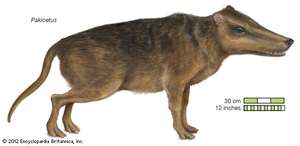Deers and whales, distant cousins

More than 50 million years ago there was a curious mammal in Pakistan that presumably lived on the banks of rivers and lakes. This mammal had the appearance of a large, elongated dog, with a thick tail and hooves. we are talking of the pakiceto, which literally means whale of Pakistan.
This gives us certain clues about the subject we are going to develop next, the evolution of cetaceans from a strange semi-aquatic dog.

The order Cetartiodactilos, whose name comes from the fusion of the groups Artiodactyla, that means pair of fingers, and Cetacea, that is related to big marine animals. Both of these groups of mammals have a high morphological variability. In this group we can find ruminants, pigs, their relatives and cetaceans. Although the cetaceans at first glance might seem different morphologically from the rest of the group, genetically they are very related and their great morphological changes have been caused by a rapid evolution when changing from the terrestrial to the underwater environment.
Thus, the ears of the pakiceto were very unusual for any terrestrial mammal, being its structure more usual in the current cetaceans. At first it was believed that Pakicetus’s ears were adapted to hear underwater since its teeth also resemble those of fossil whales. However, the anatomy of the rest of the skeleton indicated that the ears had to be adapted to hear in the air and that their aquatic specialization was produced later on. This indicates that it is a kind of transition between extinct terrestrial mammals and modern cetaceans.
Who would have thought that wild boar and whales are distant cousins!


No Comments